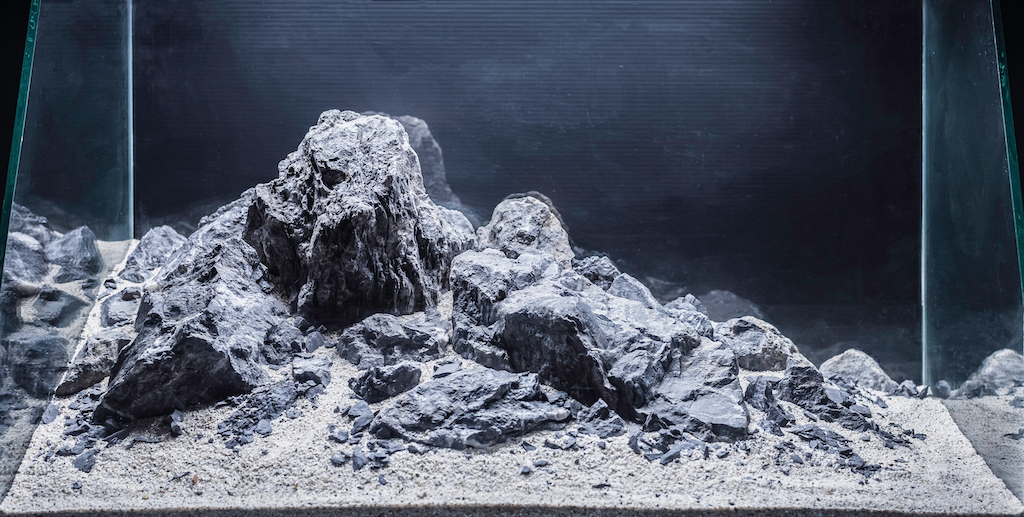If you are looking for an attractive freshwater aquascape, then the Iwagumi style is worth checking out. But what is Iwagumi aquascaping? Read on to learn about this classic aquascaping design.
*This post contains compensated links. Find more info in my DISCLAIMER. As an Amazon Associate, I earn from qualifying purchases.
What Is Iwagumi Aquascaping
Takashi Amano, a famous aquarist, developed Iwagumi aquascaping over three decades ago. This aquascaping design reflects the Japanese spirituality, love, and culture of simplicity and beauty. It also represents a minimalist layout.
Iwagumi translates to “rock formation” in Japanese and refers to a layout where stones play a crucial role. Iwagumi is not just about collecting rocks for aquascaping but also about placing them in a natural, spacious, and fluent way so that they relate to the rest of the space.
Unlike bonsai aquascaping where the centerpiece is a tree, bold stone formations and a strong commitment to creating a natural setting define Iwagumi aquascape. Utilizing stones as the fundamental aesthetic of the design and limiting aquascaping plants makes Iwagumi one of the most challenging aquascaping ideas.

This Takashi Amano aquascape design is a subset of Japanese Nature aquascaping, and it requires a significant level of experience to create and maintain. It follows a general layout that requires a perfect balance between aquascaping hardscape, open space, and scale between every design element.
The traditional Iwagumi aquascape consists of three main stones; a single large aquascaping rock and two small others. This type of Iwagumi aquascape is referred to as the Sanzon Iwagumi. It comes from the Japanese meaning a three-pillar rock formation. However, you can use any number of rocks, provided it is an odd number, to avoid a sense of symmetry.
Iwagumi Aquascaping Design Elements
Each aquascaping stone in an Iwagumi tank has a specific role, regardless of the number. Iwagumi aquascaping elements include:
Oyaishi
Oyaishi is the primary stone. It is the most beautiful and largest of all stones. This stone is always placed at the aquarium’s focal point. It usually occupies two-thirds of the aquarium’s height, following the important rule of thirds.
According to the Golden Ratio theory, the rule of thirds is the perfect ratio for the human eye. In addition, Oyaishi is slightly tilted to the water flow direction to give a natural look similar to river stones.
Fukuishi
Fukuishi is the secondary stone and should resemble Oyaishi in texture and color. It is the second-largest stone in an Iwagumi tank, and it is usually placed on the left or right of Oyaishi.
The main purpose of Fukuishi is to create tension and balance out the primary rock in the aquascape.
Soeishi
Soeishi is the third stone type and is usually placed along with the Fukuishi next to the Oyaishi. Its main purpose is to accentuate the strength of the key rock.
Suteishi
Suteishi also referred to as the sacrificial stone, is the fourth largest stone in Iwagumi aquascaping. This stone is not meant to stand out, and it is often covered by flora.
The role of Suteishi is to assist all the other rocks in creating a sense of togetherness by complimenting the entire rock formation. This stone is omitted in a Sanzon Iwagumi aquascape.
How To Assemble An Iwagumi Aquascape
These steps will help you set up your Iwagumi Aquascape:
Step One: Select Your Iwagumi Tank
A regular aquarium is okay, provided it has enough lighting. Over-tank lighting provides a very compelling overall look.
Step Two: Place a Thin Layer of Soil
Pour a thin layer of soil into the aquarium, approximately half an inch. The soil provides an ideal substrate from the beginning and throughout the tank’s life. You can add aqua soil because it provides the plants with essential food, reduces pH, and softens the water.
Step Three: Select the Primary Stone
Select and set the main stone using the golden rule to ensure aesthetic balance. Seiryu Stone, Ohko Dragon Stone, Ryuoh Stone, Elephant Skin Stone, or aquascaping Lava Rock are commonly used because they have attractive texture and color.
Step Four: Place the Secondary Stones
Add the remaining stones, starting with the larger ones. Ensure all the rocks appear balanced and natural in relation to each other and the entire design.
Step Five: Install Driftwood
Though most aquarists don’t incorporate aquascaping driftwood in Iwagumi aquascaping, you can choose to add it to enhance the aesthetics of the aquarium.
Step Six: Add Your Plants
After the stones are set, you can slowly fill one-thirds of the aquarium with water and plant up. Some of the most popular aquatic plants in Iwagumi landscaping are aquascaping moss, Hairgrass aquarium, Monte Carlo, and Dwarf Baby Tears. Hairgrass and moss for aquascaping are ideal for carpeting the aquarium floor.
Step Seven: Fill Up the Aquarium With Water and Add Fish
After planting your plants in the aquarium, slowly fill up the Iwagumi tank and add fish or shrimp if you please.
Best Iwagumi Aquascaping For Home
Iwagumi is an aquascaping design that requires skills and experience to create. However., with the following Iwagumi kits and accessories, you can easily create your own Iwagumi tank.
Ohko Dragon Stone Aquascape Aquarium Rock Decor

The Ohko Dragon Stone is named after its stunning texture that features an earthly blend of brown, yellow, green, and red hues. This aquarium stone also has deep crevices that give a near-dragon-scale appearance.
This aquarium hardscape is crafted from hand-selected stones. It’s ideal for both bonsai and Iwagumi aquascaping. The stone’s detailed structure is perfect for anchoring aquatic plants and creates safe hiding places for fish.
Sejahtera Dragon Stone Aquascaping Aquarium

This dragon stone is soft and features distinctive pits and grooves shaped by nature. It has a brittle clay-like structure that you can easily break into smaller pieces using a hammer and chisel.
Most of these stones and oblong-shaped, making them easy to set in a substrate. They are common in Iwagumi aquascaping, where the focal point is on the rocks. The rocks are randomly picked, making them available in different shapes and sizes.
CARIBSEA INC Natural Corral Aquascaping Rocks

CARIBSEA rock is made from an aragonitic base rock that contains a network of macro and micro pores that intertwine its internal structure. These pores create the ideal habitat for natural nitrifying bacteria.
Each manmade rock has an artificial texture and coating that mimics natural coral algae. The box has a mixture of tunnels, arches, and rings that give you unique-looking pieces that you can use as accents to the rest of the aquascape.
CURRENT USA Seiryu Stone Collection

You can create a unique Iwagumi aquascape using this Seiryu stone collection that contains between seven and 11 pieces. Seiryu Stone has a rough, jagged texture and a deep silver-gray color, making it a stunning focal point in Iwagumi landscaping.
This Seiryu Stone collection is sculpted from hand-picked stones. It features the same detailed crevices, deep cuts, and sharp edges found in natural stones. Each molded Seiryu stone is painted to give a bit of uniqueness and realistic detail.
Aquascape Aquarium Mountain Coral Reef Rock

This Mountain Coral Reef Rock not only brings a beautiful personality to your Iwagumi tank but also provides a natural environment and shelter for your fish. The rock is non-toxic and tasteless and thus does not affect the fish’s health.
The rock is made from a high-temperature casting mold that is beautiful and vivid. A long soak in an Iwagumi tank does not stain its color.
Iwagumi aquascaping is a unique way of creating an attractive focal point. However, creating such an aquascape requires patience and skills. This article provides you with a guide that helps you create your own Iwagumi tank.
